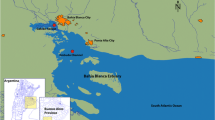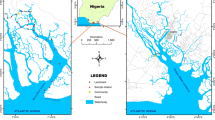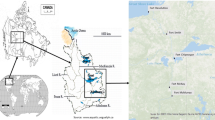Abstract
Polycyclic aromatic hydrocarbons (PAHs) are mistakenly consumed by people through their diet, including food and water. The occurrence, source, and health hazards of 16 PAHs in 36 tilapia (Sarotherodon melanotheron) and silver catfish (Chrysichthys nigrodigitatus) samples from Okulu River, Nigeria were investigated in this study. The total PAH concentration ranged from 11.70–24.20 to 13.40–19.60 µg/kg, being statistically different between the two species. The values were higher than the European Commission limits of 12 µg/kg and within the World Health Organization limit of 20 µg/kg. The 16 PAHs were detected in both fish species. The diagnostic ratio revealed that petroleum, fossil fuel, and incomplete combustion of biomass wastes were the sources of PAHs in the fishes. Pearson’s correlation showed that the PAHs can come from diverse sources. The non-carcinogenic risk quotients (HQs) and hazard index (HI) in both fish species were 1, an indication of no adverse health effects. Among the 9 PAHs that were used to calculate the HI, BaP and BgP accounted for 31% and 62%, respectively, for Chrysichthys nigrodigitatus, and 25% and 69%, respectively, for Sarotherodon melanotheron. The carcinogenic hazard of the 7 PAHs assessed was within the acceptable range of 10−6–10−4. But the sum of the carcinogenic hazard was on the order of 10−3 in both species of fish, an indication of carcinogenic health effects. 79% and 75% of the total carcinogenic risk for Chrysichthys nigrodigitatus and Sarotherodon melanotheron, respectively, are from DaA and InP. The consumption of PAHs by residents of the study area and other population groups through fish foods from the studied river underlines the importance of checking PAHs in aquatic foods for health concerns on a frequent basis.


Similar content being viewed by others
Data availability
The raw data are available on request.
References
Adeniji, A. O., Okoh, O. O., & Okoh, A. I. (2019a). Levels of polycyclic aromatic hydrocarbons in the water and sediment of Buffalo River Estuary, South Africa and their health risk assessment. Archives of Environmental Contamination and Toxicology, 76(4), 657–669.
Adeniji, A. O., Okoh, O. O., & Okoh, A. I. (2019b). Distribution pattern and health risk assessment of polycyclic aromatic hydrocarbons in the water and sediment of Algoa Bay. South Africa. Environmental Geochemistry and Health, 41(3), 1303–1320.
Adeniji, A. O., Okoh, O. O., & Okoh, A. I. (2018). Analytical methods for polycyclic aromatic hydrocarbons and their global trend of distribution in water and sediment: a review. In: Manar El-Sayed Abdul- Raouf (ed). Recent insights in petroleum science and engineering. ISBN: 978–953–51–5321–4. https://doi.org/10.5772/intechopen.71163
Adeyi, A. A., & Oyeleke, P. (2017). Heavy metals and polycyclic aromatic hydrocarbons in soil from e-waste dumpsites in Lagos and Ibadan. Nigeria. Journal of Health and Pollution, 7(15), 71–84.
Aigberua, A., & Tarawou, T. (2019). Water quality index (WQI) assessment along inland fresh waters of Taylor Creek in Bayelsa State. Nigeria. Journal of Environmental Treatment Techniques, 7(3), 260–269.
Aigberua, A. O. (2019). Quantitative oil source fingerprinting and diagnostic ratios: Application for identification of soil residual hydrocarbon (SRH) in waste dump areas within oil well clusters. Journal of Environmental Treatment Techniques, 7(2), 220–228.
Aigberua, A. O. (2020). A survey of concentrations and source characterization of polycyclic aromatic hydrocarbons in surface waters of the Imiringi river system. International Research Journal of Pure & Applied Chemistry, 21(10), 71–84.
Aigberua, A. O., & Seiyaboh, E. I. (2021). Distribution trends and source diagnosis of polycyclic aromatic hydrocarbons (PAHs) in sediments of Imiringi River. Current World Environment, 16(2), 607–621.
Aigberua, A. O., Izah, S. C., & Richard, G. (2021). Hazard analysis of trace metals in muscle of Sarotherodon melanotheron and Chrysichthys nigrodigitatus from Okulu River, Rivers State, Nigeria. Journal of Environmental Health and Sustainable Development, 6(3), 1340–1356.
Atobatele, O. E., & Ugwumba, A. O. (2011). Condition factor and diet of Chrysichthys nigrodigitatus and Chrysichthys auratus (Siluriformes: Bagridae) from Aiba Reservoir, Iwo. Nigeria. Revista De Biología Tropical, 59(3), 1233–1244.
Ayoade, A. A., & Ikulala, A. O. (2007). Length weight relationship, condition factor and stomach contents of Hemichromis bimaculatus, Sarotherodon melanotheron and Chromidotilapia guentheri (Perciformes: Cichlidae) in Eleiyele Lake. Southwestern Nigeria. Revista De Biología Tropical, 55(3–4), 969–977.
Ben-Eledo, V. N., Kigigha, L. T., Izah, S. C., & Eledo, B. O. (2017a). Water quality assessment of Epie creek in Yenagoa metropolis, Bayelsa state. Nigeria. Archives of Current Research International, 8(2), 1–24.
Ben-Eledo, V. N., Kigigha, L. T., Izah, S. C., & Eledo, B. O. (2017b). Bacteriological quality assessment of Epie Creek, Niger Delta Region of Nigeria. International Journal of Ecotoxicology and Ecobiology, 2(3), 102–108.
Carlson, J., Wysoczanski, A., & Voigtman, E. (2014). Limits of quantitation—yet another suggestion. Spectrochimica Acta Part B: Atomic Spectroscopy, 96, 69–73.
Delaware Health and Social Services (2015). Benzo(a)pyrene. https://dhss.delaware.gov/dph/files/benzopyrenefaq.pdf. Accessed 3 May 2022.
Ekere, N., Yakubu, N., & Ihedioha, J. (2017). Ecological risk assessment of heavy metals and polycyclic aromatic hydrocarbons in sediments of rivers Niger and Benue confluence, Lokoja, Central Nigeria. Environmental Science and Pollution Research, 24(23), 18966–18978.
Ekere, N. R., Yakubu, N. M., Oparanozie, T., & Ihedioha, J. N. (2019). Levels and risk assessment of polycyclic aromatic hydrocarbons in water and fish of Rivers Niger and Benue confluence Lokoja, Nigeria. Journal of Environmental Health Science and Engineering, 17(1), 383–392.
El Nemr, A., Moneer, A. A., Ragab, S., & El Sikaily, A. (2016). Distribution and sources of n-alkanes and polycyclic aromatic hydrocarbons in shellfish of the Egyptian Red Sea coast. The Egyptian Journal of Aquatic Research, 42(2), 121–131.
European Commission. (2015). EC regulation 2015/1933 amending EC regulation 1881/2006 regarding maximum levels of PAHs in foodstuffs, Torino Italy. 2015.
Federal Republic of Nigeria (FRN). (2010). Fourth National Biodiversity Report. FRN, Abuja, Nigeria.
Huang, C. L., Bao, L. J., Luo, P., Wang, Z. Y., Li, S. M., & Zeng, E. Y. (2016). Potential health risk for residents around a typical e-waste recycling zone via inhalation of size-fractionated particle-bound heavy metals. Journal of Hazardous Materials, 317, 449–456.
Indorama Eleme Fertilizer and Chemicals LTD. (2017). Draft EIA report for the proposed IEFCL-Train 2 fertilizer Project in Indorama complex Eleme, Port Harcourt, Rivers State. Submitted to Federal ministry of environment, Federal secretariat, Abuja, Nigeria.
Iwegbue, C. M., & Obi, G. (2016). Distribution, sources, and health risk assessment of polycyclic aromatic hydrocarbons in dust from urban environment in the Niger Delta, Nigeria. Human and Ecological Risk Assessment: An International Journal, 22(3), 623–638.
Iwegbue, C. M., Ehigbor, M. J., Tesi, G. O., Eguavoen, O. I., & Martincigh, B. S. (2021). Occurrence, sources and exposure risk of polycyclic aromatic hydrocarbons (PAHs) in street dusts from the Nigerian megacity. Lagos. Polycyclic Aromatic Compounds, 42(1), 49–69.
Izah, S. C., Iyiola, A. O., & Richard, G. (2023a). Impacts of Pollution on the Hydrogeochemical and Microbial Community of Aquatic Ecosystems in Bayelsa State, Southern Nigeria. In: Madhav S, Singh VB, Kumar M, Singh S (Editors). Hydrogeochemistry of aquatic ecosystems. Published by John Wiley & Sons Ltd. Pp. 283 – 305. https://doi.org/10.1002/9781119870562.ch13
Izah, S. C., Ngun, C. T., & Richard, G. (2022a). Microbial quality of groundwater in the Niger Delta region of Nigeria: Health implications and effective treatment technologies. In: Srivastav AL, Madhav S, Bhardwaj AK, Valsami-Jones E (Editors). Urban Water Crisis and Management: Strategies for Sustainable Development. Current Directions in Water Scarcity Research. Pp. 149–172. Elsevier. https://doi.org/10.1016/B978-0-323-91838-1.00010-5
Izah, S. C., Ngun, C. T., Iniaghe, P. O., Aigberua, A. O., & Odubo, T. C. (2023b). Processes of decontamination and elimination of toxic metals from water and wastewaters. In: Shukla SK, Kumar S, Madhav S, Mishra PK (editors). Metals in water: global sources, significance, and treatment. Woodhead Publishing Advances in Pollution Research. Elsevier. Pp. 239 – 262. https://doi.org/10.1016/B978-0-323-95919-3.00003-3
Izah, S. C., Aigberua, A. O., & Srivastav, A. L. (2022b). Factors influencing the alteration of microbial and heavy metal characteristics of river systems in the Niger Delta region of Nigeria. In: Ecological Significance of river ecosystem: Challenges and management. Madhav S, Kanhaiya S, Srivastav AL, Singh VB and Singh P (Editors). Published in United Kingdom by Elsevier Pp. 51–78. https://doi.org/10.1016/B978-0-323-85045-2.00005-4
Izah, S. C., Aigberua, A. O., & Richard, G. (2022c). Concentration, source, and health risk of trace metals in some liquid herbal medicine sold in Nigeria. Biological Trace Element Research, 200(6), 3009–3022.
Izah, S. C., Aigberua, A. O., & Ogwu, M. O. (2022d). Trace element composition of Gallus gallus domesticus eggs and health risks associated with their consumption in Port Harcourt, Nigeria. Journal of Food Safety and Hygiene, 8(3), 202–222.
Izah, S. C., Uzoekwe, S. A., & Aigberua, A. O. (2021). Source, geochemical spreading and risks of trace metals in particulate matter 2.5 within a gas flaring area in Bayelsa State, Nigeria. Advances in Environmental Technology, 7(2), 101–118
Izah, S. C., Aigberua, A. O., & Nduka, J. O. (2018). Factors affecting the population trend of biodiversity in the Niger Delta region of Nigeria. International Journal of Avian & Wildlife Biology, 3(3), 199–207.
JECFA. (2005). Summary and conclusions. In: Joint FAO/WHO Expert Committee on Food Additives. Sixty-fourth Meeting, Rome, 8–17 February 2005.
Moslen, M., & Aigberua, A. (2018a). Sediment contamination and ecological risk assessment in the upper reaches of the Bonny Estuary, Niger Delta, Nigeria. Journal of Environmental Toxicology and Public Health, 3, 1–8.
Moslen, M., & Aigberua, A. (2018b). Heavy metals and hydrocarbon contamination of surface water in Azuabie Creek within Bonny Estuary, Nigeria. Journal of Applied Sciences and Environmental Management, 22(7), 1083–1088.
New Jersey Department of Health. (2015). Hazardous substance fact sheet. https://dhss.delaware.gov/dph/files/benzopyrenefaq.pdf. Accessed 03 May 2022.
Nkpaa, K. W., Wegwu, M. O., & Essien, E. B. (2013). Assessment of polycyclic aromatic hydrocarbons (PAHs) levels in two commercially important fish species from crude oil polluted waters of Ogoniland and their carcinogenic health risks. Journal of Environment and Earth Science, 3(8), 128–137.
Nudi, A. H., & de LR Wagener, A., Francioni, E., Sette, C. B., Sartori, A. V., & Scofield, A. D. L. (2010). Biomarkers of PAHs exposure in crabs Ucides cordatus: Laboratory assay and field study. Environmental Research, 110(2), 137–145.
Ogamba, E. N., Charles, E. E., & Izah, S. C. (2021). Distributions, pollution evaluation and health risk of selected heavy metal in surface water of Taylor creek, Bayelsa State. Nigeria. Toxicology and Environmental Health Sciences, 13(2), 109–121.
Rabalais, N. N. (2015). Human impacts on fisheries across the land–sea interface. Proceedings of the National Academy of Sciences, 112(26), 7892–7893.
Rojo-Nieto, E., Sales, D., & Perales, J. A. (2013). Sources, transport and fate of PAHs in sediments and superficial water of a chronically polluted semi-enclosed body of seawater: Linking of compartments. Environmental Science: Processes & Impacts, 15(5), 986–995.
Sasu, D. D. (2022). Life expectancy at birth in Nigeria 2021, by gender. https://www.statista.com/statistics/1122851/life-expectancy-in-nigeria-by-gender/#:~:text=In%202021%2C%20life%20expectancy%20at,and%2063%20years%20for%20females. Accessed 3 May 2022.
Seiyaboh, E. I., & Izah, S. C. (2017a). Bacteriological assessment of a tidal creek receiving slaughterhouse wastes in Bayelsa state, Nigeria. Journal of Advances in Biology and Biotechnology, 14(1), 1–7.
Seiyaboh, E. I., & Izah, S. C. (2017b). Review of impact of anthropogenic activities in surface water resources in the Niger delta region of Nigeria: A case of Bayelsa state. International Journal of Ecotoxicology and Ecobiology, 2(2), 61–73.
Taiwo, A. M., Ihedioha, E. C., Nwosu, S. C., Oyelakin, O. A., Efubesi, P. C., Shitta, J. S., & Osinubi, T. O. (2019). Levels and health risk assessment of polycyclic aromatic hydrocarbons in protein foods from Lagos and Abeokuta, Southwestern Nigeria. Journal of Food Composition and Analysis, 79, 28–38.
Tarawou, T., Erepamowei, Y., & Aigberua, A. (2021). Determination of sources, spatial variability, and concentration of polycyclic aromatic hydrocarbons in surface water and sediment of Imiringi River. World Journal of Advanced Research and Reviews, 9(3), 309–318.
Tongo, I., Ogbeide, O., & Ezemonye, L. (2017). Human health risk assessment of polycyclic aromatic hydrocarbons (PAHs) in smoked fish species from markets in Southern Nigeria. Toxicology Reports, 4, 55–61.
Tzoraki, O., Karaouzas, I., Patrolecco, L., Skoulikidis, N., & Nikolaidis, N. P. (2015). Polycyclic aromatic hydrocarbons (PAHs) and heavy metal occurrence in bed sediments of a temporary river. Water, Air, & Soil Pollution, 226(12), 1–19.
Udofia, U. S., Ameh, C., Miller, E., & Ekpenyong, M. S. (2021). Investigating the origin and tissue concentration of polycyclic aromatic hydrocarbons in seafood and health risk in Niger Delta. Nigeria. Environmental Science: Processes & Impacts, 23(11), 1803–1814.
Uzoekwe, S. A., Izah, S. C., & Aigberua, A. O. (2021). Environmental and human health risk of heavy metals in atmospheric particulate matter (PM10) around gas flaring vicinity in Bayelsa State. Nigeria. Toxicology and Environmental Health Sciences, 13(4), 323–335.
Vogt, N. B., Brakstad, F., Thrane, K., Nordenson, S., Krane, J., Aamot, E., Kolset, K., Esbensen, K., & Steinnes, E. (1987). Polycyclic aromatic hydrocarbons in soil and air: Statistical analysis and classification by the SIMCA method. Environmental Science & Technology, 21(1), 35–44.
Wolska, L., Mechlińska, A., Rogowska, J., & Namieśnik, J. (2012). Sources and fate of PAHs and PCBs in the marine environment. Critical Reviews in Environmental Science and Technology, 42(11), 1172–1189.
Yan, M., Nie, H., Wang, W., Huang, Y., & Wang, J. (2018). Occurrence and toxicological risk assessment of polycyclic aromatic hydrocarbons and heavy metals in drinking water resources of Southern China. International Journal of Environmental Research and Public Health, 15(7), 1422.
Zhang, S., Yao, H., Lu, Y., Yu, X., Wang, J., Sun, S., & Zhang, D. (2017). Uptake and translocation of polycyclic aromatic hydrocarbons (PAHs) and heavy metals by maize from soil irrigated with wastewater. Scientific Reports, 7(1), 1–11.
Zhao, Z., Qin, Z., Cao, J., & Xia, L. (2017). Source and ecological risk characteristics of PAHs in sediments from Qinhuai River and Xuanwu Lake, Nanjing, China. Journal of Chemistry, 2017.
Acknowledgements
The authors are thankful to the Environment, Research and Development department of Anal Concept Limited, Port Harcourt, Nigeria, for her full-fledged collaboration in the course of this research.
Funding
The study was financially supported by Anal Concept Limited.
Author information
Authors and Affiliations
Contributions
AOA conceived the idea and participated in the field data/sample collection, and laboratory analysis. SCI carried out the statistical analysis. AAA managed the literature search. All authors wrote the initial draft, read and approved the final manuscript.
Corresponding author
Ethics declarations
Ethical approval
This paper does not contain any human participants or animals.
Consent to participate
Not applicable.
Consent to publish
Not applicable.
Competing interests
The authors declare no competing interests.
Additional information
Publisher's Note
Springer Nature remains neutral with regard to jurisdictional claims in published maps and institutional affiliations.
Rights and permissions
Springer Nature or its licensor (e.g. a society or other partner) holds exclusive rights to this article under a publishing agreement with the author(s) or other rightsholder(s); author self-archiving of the accepted manuscript version of this article is solely governed by the terms of such publishing agreement and applicable law.
About this article
Cite this article
Aigberua, A.O., Izah, S.C. & Aigberua, A.A. Occurrence, source delineation, and health hazard of polycyclic aromatic hydrocarbons in tissues of Sarotherodon melanotheron and Chrysichthys nigrodigitatus from Okulu River, Nigeria. Environ Monit Assess 195, 364 (2023). https://doi.org/10.1007/s10661-023-10970-y
Received:
Accepted:
Published:
DOI: https://doi.org/10.1007/s10661-023-10970-y




